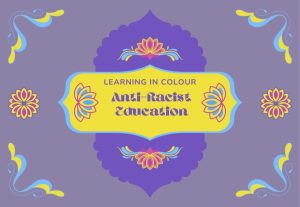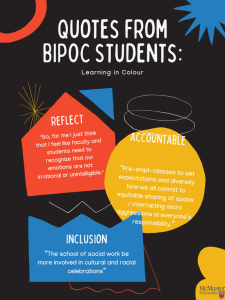20 What is anti-racist education?

Anti-racist education is making explicit, thoughtful, and intentional links between histories of racism imbued within pedagogical practices and classroom spaces.
What is racism?
To understand “anti-racism,” we need to have an understanding of “racism.”
Merriam-Webster defines racism as “a belief that race is a fundamental determinant of human traits and capacities and that racial differences produce an inherent superiority of a particular race.”
The origins of white supremacy and racism are linked to projects of colonization, imperialism, and capitalism, where Eurocentric efforts to expand white ruling and sovereignty across physical spaces were informed by naturalist claims of white superiority. For example, Johann Blumenbach, an 18th century German physician and anthropologist, devised a “racial hierarchy” on a pyramid that placed “Caucasians” at the top, where he claimed that “other” races were “degenerative” from the pinnacle white standard of God’s creation. Other prominent white figures in history, including Thomas Jefferson and Samuel Morton, furthered this rhetoric by making violent claims about the inferiority of racialized persons on the basis of unethical, faulty, and false “science.”
Here, we see racism as inherently linked to projects of eugenics (which refers to Francis Galton’s theorizing around breeding and reproducing “good genes” in an attempt to create an “ideal” white, able-bodied society), colonialism, imperialism, and indentureship, where racialized persons have been violated, oppressed, marginalized, violently displaced, abducted, murdered, tortured, and forced into violent practices of white supremacy (e.g. genocidal institutions, slavery, etc.) based on claims that race is a “science” or a product of inherent, biological differences. However, ongoing work from racialized scholars, activists, theorizers, scientists, and their allies have disproven these claims and pointed to the ways in which race is a social construct. For example, research from Richard Lewontin, a geneticist from the 1970s, indicates that 85% of human variation can be found within any local population, meaning that the human species is much more similar than we appear. In other words, perceived differences on the basis of race are informed by social construction, not by biological difference.
Although race is a social construct, the impacts of racism are real, tangible, historical, and ongoing. Beliefs about white superiority continue to govern social institutions, structures, and spaces that we work and live within as they are built on foundations of white supremacy and racism. For example, many common practices in our western educational upbringing, including standardized testing, “IQ,” what counts as “real” or “reliable” knowledge, and the ways in which learning is facilitated (e.g. in classroom structure and lecture formats), were built on beliefs about naturalized intelligence, whiteness, and Eurocentric epistemologies. Here, racism extends beyond “belief” into material actions and ideologies that continue to shape our contemporary experiences.
What is anti-racist education?
According to Sefa Dei and Lara-Villanueva (2021), anti-racist education is, “about recognizing, through teaching, the meaningfulness of race while examining the links between racism today and Canada’s history of colonialism. Racism is not only about individual acts of prejudice, violent attitudes, negative perceptions and stereotypes that people may have. Due to Canada’s colonial history, racism has been structurally embedded as a practice in schools. This is generally acknowledged as systemic racism and is reflected in the various ways that power and privilege work to discriminate against students who belong to minority groups.”
Here, there is an acknowledgment that racism is embedded in the fabric of Western education, where academic institutions are built upon legacies of colonialism and racism. In this way, the “anti” of “anti-racism” is elusive; can we ever be anti-racist in a racist institution? It is within this question that we ask you to push yourself out of microlevel considerations of racism that are fundamentally concerned about white educators’ roles, experiences, and identities. Rather, we understand racism as a sociostructural issue – socially constructed with tangible implications – that can be experienced and enacted on an individual level; however, it must always be understood as a larger system that governs the structures and spaces that we interact with and operate within daily.
However, for the purposes of this discussion, we can also understand anti-racist education as a microlevel enactment of attempts to recognize the realities of how racism impacts racialized students’ learning and engagement in classes and courses. Anti-racist education would resist sanitized colourblind impulses that rely of fallacies of equality to instead focus on the tangible consequences of racism and the inequity it facilitates. For anti-racist educators, race, racism, and racialization are discussions that are foundational to their courses and integrated readily into its structure. Anti-racist education demands constant self-reflection and reflexivity on the part of white educators to challenge their own biases, assumptions, and approaches to teaching and learning. It is a historically grounded practice that seeks to actively dismantle oppressive systems within educational institutions to pursue alternative methods that embrace non-Eurocentric ways of knowing and learning.
Troubling the “Anti” of “Anti-Racism”
Anti-racist education has become something of particular focus for educators and, at times, a bit of a buzzword. Anti-racist education here refers to making explicit, thoughtful, and intentional links between histories of racism imbued within pedagogical practices and classroom spaces. Anti-racism involves a deliberate and thoughtful de-centering of whiteness within course content, assignment structure, and assessment practices for student learning by carefully re-working existing syllabi, readings, videos, lectures, and assignments.
It is important to recognize that the “anti” of “anti-racism” can be elusive and, arguably, unachievable. As Ameil Joseph notes, “[w]hen confluence and violence are appreciated for their fluidity and complexity, the position of ‘anti’ is impossible, as we are all in a position of complicity” (p.33-34). Here, we encourage you to understand that, while you can explore and deploy more inclusive practices that challenge existing and oppressive ways of doing things, you must also appreciate and acknowledge that you are always complicit in violence and “caught in representations” that trouble the possibilities of “anti-racism.” For example, by virtue of being a representative of a western academic institution, being white, and teaching classes in the typical way (e.g. lecture format), you are occupying a place of power and powerlessness simultaneously: you’re an agent of a Eurocentric institution with the power to gatekeep and shape learning, while you are also at mercy to the broader demands of your workplace and the institution as a whole.
If we become overly fixated on obtaining and embodying the “anti” of “anti-racism,” we may gloss over the central issues shaping unsafe classroom spaces and inadvertently perpetuate the processes and dynamics that make racialized students feel unsafe. Often, people attempt to distance themselves from the label of “racism” by outwardly identifying as an “ally” or as an “anti-racist,” when these are not necessarily titles that can be self-bestowed or claimed. We encourage folks to lean into the discomfort of knowing that the “anti” might not be possible, especially when we work within oppressive educational contexts that are structured in a way that upholds Eurocentric epistemologies and colonial legacies (e.g. in physical classroom spaces, in assessment practices, and in lecture/readings/assignment design). Try to focus on the tangible steps that you can take to challenge oppressive practices rather than “achieving” anti-racism.
Actionable Anti-Racist Steps

Columbia University’s Centre for Teaching and Learning assembled a resource to provide some actionable steps involved in leading anti-racist pedagogy. These include:
- Self-educate and acknowledge the racial trauma that racialized students experience both inside and outside of the classroom
- This involves continued self-reflection and efforts to seek out historically rooted and contemporary sources of knowledge
- Interrogate your positionality, social location, and (un)conscious bias through personal work and reflection
- Do this work before you ask students to do the same, but also ensure you’re re-orienting the discussion to structures and systems rather than a hyperfocus on microlevel experiences
- Address gaps and issues through intentional curricular design and evaluation
- Deliberately decentre whiteness and integrate the voices and perspectives of marginalized persons through intentional choices about course content
- Foster a respectful, compassionate, safer, and accountable class community and meet students where they are at
- Embrace “difficult dialogues,” but also ensure you are facilitating them in a way that does not tokenize, spotlight, or demand labour from racialized students
- Engage the campus community more broadly and pursue action outside of the classroom
- Re-orient discussions of anti-racism to structural factors and encourage students to pursue this work outside of campus boundaries as well
These include:
